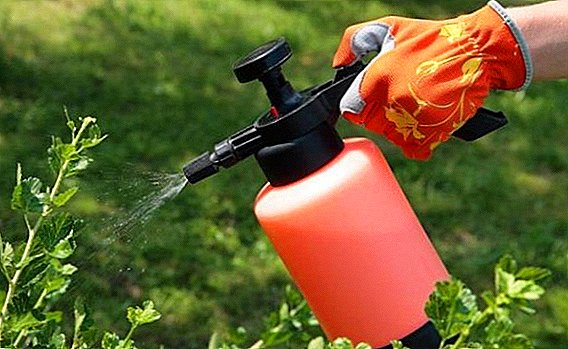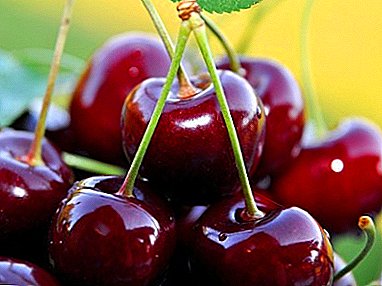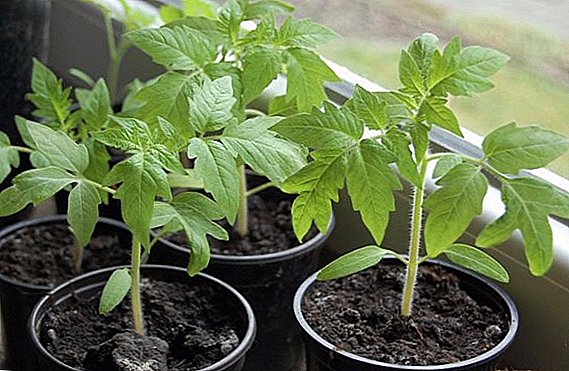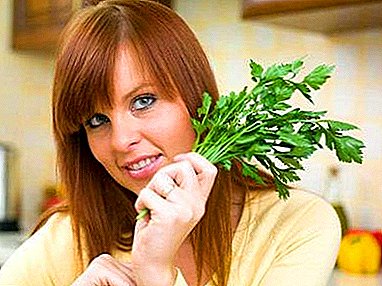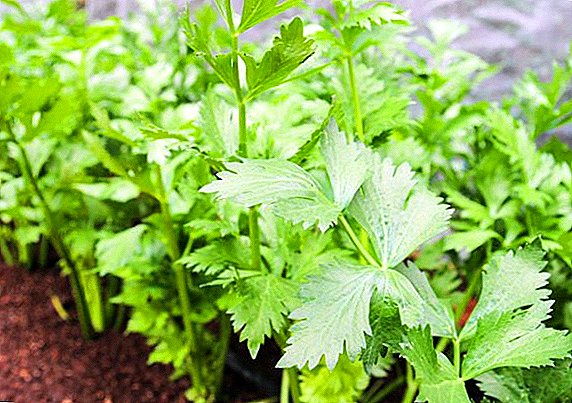 In each garden and cottage allocated a plot for greenery, including parsley. It is an essential ingredient of fresh salads, preserved, first and second courses. To grow lush green bushes on the garden, you need to properly care for them. How to do this is described in this article.
In each garden and cottage allocated a plot for greenery, including parsley. It is an essential ingredient of fresh salads, preserved, first and second courses. To grow lush green bushes on the garden, you need to properly care for them. How to do this is described in this article.
Types and parsley varieties
This biennial plant belongs to the roots of the umbrella family and the subfamily Celery. In the first year sprigs grow with leaves, collected in a rosette at the root. And in the second year there is a bush that blooms and produces seeds. The Greek word translated “parsley” literally means “mountain celery”, which means that the culture is unpretentious. This aromatic herb with beautiful carved leaves is from the Mediterranean. It was a favorite spice among the ancient Greeks and Romans.
The genus Petrushka has only two types:
- root (grown for root);
- leaf (gives lush green).

Root
Parsley root has a strong root, which is formed in the first year after planting. A thick and fleshy root crop resembles a carrot, only white-yellow in color, with the shape of a regular elongated cone. Green mass grows not very lush and with fewer branches. The leaves are edible, but slightly rougher than those of leafy varieties. The virtue of the form - fragrant root, juicy and healthy. It is simply indispensable in the preparation of hot dishes and marinades.
Important! It is not recommended to cut the greens at the root of the parsley before how the root is fully formed. Otherwise, the root will lag in size and quality.
- Sugar - a fruitful and early ripe grade, ripens in 93-95 days; root crops grow up to 30 cm in length, gain a weight of 130-160 g and have an excellent taste;
- Alba refers to late varieties (ripening period - 180 days), has large roots (weight - 200-300 g, diameter - up to 8 cm, length - 25 cm) with good taste, gives a decent harvest and is well stored;
- Eagle - medium grade with white even conical roots up to 30 cm in length and weighing about 150 g; resistant to diseases, high and low temperatures;
- Orbis - medium-early variety with white roots weighing up to 170 g, valued for disease resistance and great taste, perfectly stored in the winter;
- Fruitful - a kind of average ripening time, has white roots up to 20 cm in length, juicy and tasty; distinguished by immunity to diseases and remarkable stability.

Leafy
Leaf parsley is more popular among gardeners. It can often be found at cottages, balconies and window sills. The rhizome of this species is also powerful, but more subtle and strongly branched. It is not used in writing. Leaf varieties are grown for fragrant greens. One bush can give 50-100 branches, densely covered with carved leaves. They can be cut several times in one season. The leaves are dried and frozen, while they do not lose their taste and useful properties.
Did you know? According to ancient Greek mythology, parsley grew where there was shed the blood of the slain dragon Opelt, the son of the ruler of the Nemean region. The Nemean Games were organized in his honor.
Among the best smooth-leaved varieties the following should be mentioned:
- Carnival - a very early variety (yields in 65-75 days), high-yielding (about 3 kg / m²), the socket may consist of 100 large fragrant leaves on high petioles, unpretentious and not afraid of shade;
- Breeze - a type of medium maturity (80 days), has dark green leaves, which, together with the petioles, reach 75 cm, but are not prone to lodging, after cutting they do not wither for a long time and do not lose their taste, often cultivated for sale;
- Bogatyr ripens late, is resistant to cold and heat, grows well in partial shade, the leaves are very fragrant, grow quickly after cutting;
- Belladonna refers to early-ripe varieties, forms a lush low rosette of large dark green leaves that emit a strong piquant aroma;
- Titanium - mid-season variety with fragrant leaves, does not suffer from fungal diseases, resistant to adverse conditions (frost and drought)

Curly
Curly subspecies leaf parsley is distinguished by its appearance. The leaves are very corrugated and curly. Due to this, green twigs look very aesthetically pleasing both on the garden and on the table.
Learn more about the beneficial and harmful properties of curly parsley.
Among curly varieties are such varieties:
- Aster - very early variety (less than 2 months), high-yielding (up to 5 kg / m²), curly leaves with a pleasant aroma form a very dense outlet, grow quickly after cutting, grows well in the open and closed ground;
- Moskrause - medium early variety (70-80 days), curly leaves have a strong aroma, which persists even after drying, has cold and drought resistance;
- Curly milan early variety (60-70 days), dense rosette formed from the lush dark green leaves, which have an excellent taste and aroma, can withstand the cold.

Useful properties and contraindications to the use
Parsley is so popular not only because of its culinary characteristics, but because of the beneficial properties it possesses. It has a very rich vitamin and mineral composition:
- vitamins C, A, E, K, PP, B1, B2, B6 and B9;
- minerals: iron, magnesium, potassium, calcium, zinc, phosphorus, sodium, manganese, copper and selenium.
Did you know? The content of ascorbic acid in parsley is four times higher than in lemon. And beta carotene in it as much as in carrots.
Each of these chemical elements has a positive effect on the human body. Therefore, parsley (all its parts) has many useful properties. Among them should be called:
- increase the protective functions of the body;
- normalization of metabolism;
- an obstacle to the development of anemia;
- removal of inflammation, swelling and pain in the joints of arthritis;
- strengthening the walls of blood vessels;
- detoxification of the blood;
- normalization of blood sugar levels;
- stabilization of blood pressure and pulse;
- relief from seasonal allergies, allergic rhinitis;
- reducing the acidity of gastric juice and the normalization of the digestive tract;
- treatment and prevention of diseases of the urinary organs;
- disinfection of the oral cavity and getting rid of unpleasant odor, strengthening gums;
- treatment of inflammatory processes in the kidneys;
- diuretic action;
- increases visual acuity;
- treatment of skin inflammation, cell regeneration of the epidermis, wound healing;
- normalization of the functions of the adrenal glands and the thyroid gland;
- improved brain function;
- beneficial effects on the nervous system.
 The composition of the spicy grass is apiol, which by its properties is very similar to estrogen, a female hormone. Therefore, parsley is very useful for women, as it beneficial effects on female organs:
The composition of the spicy grass is apiol, which by its properties is very similar to estrogen, a female hormone. Therefore, parsley is very useful for women, as it beneficial effects on female organs:- regulates the menstrual cycle and contributes to its painless flow;
- reduces the appearance of PMS;
- eliminates unpleasant signs of menopause;
- relieves mental and physical stress.
Read also about the beneficial properties of parsley for women's health.
Also, the vegetable has a good effect on the skin, slows down its aging. But, despite the huge number of useful characteristics of parsley, it should be used sparingly. It contains myristicin - an active substance, the excess of which can lead to bad consequences: headache, nausea, dizziness, hallucinations, seizures and excessive weight loss. In some diseases and conditions, the use of vegetables is absolutely contraindicated. These include:
- pregnancy, as it can provoke miscarriage;
- nephritis and other kidney diseases;
- urolithiasis disease;
- acute cystitis;
- gout;
- hypocalcemia;
- skin sensitivity.

Features of planting and cultivation of parsley in the open ground from seeds
Seeds can be sown immediately in open ground. But you need to find a suitable place and prepare the land. Place requirements:
- well lit (some varieties grow well in partial shade);
- the soil should be fertile and loose, permeable to water and air, with normal acidity;
- There should be no close occurrence of groundwater.
Good predecessors: potatoes, tomatoes, onions, cabbage, cucumbers, zucchini and beets. It is better not to plant parsley after dill, carrots, cumin and cilantro. The site must be prepared in advance, for example, for spring planting in autumn. To do this, you should dig deep future beds with simultaneous introduction of organic matter (humus or compost).
Important! After parsley and other celery, it can be planted not earlier than in 3-4 years.
Seed preparation for sowing
Celery seeds sprout very slowly, about 2-3 weeks. This is explained by the fact that each seed is covered with a protective layer of essential oils, which slow down the spelling. To prepare the seeds for planting, you can take the following steps:
- immerse them in warm water for 1-2 days or hold them under running hot water for 25 minutes;
- soak for several hours in a solution of growth stimulant (epine or potassium humate);
- leave on a damp napkin for a couple of days to hatch.

Planting scheme
Sowing is carried out as follows:
- the groove depth is 1-2 cm;
- distance between rows - 20-40 cm.
Important! Before autumn sowing seeds soak is not worth it. In the dry form, they better winter in the ground.
Seed planting process:
- Wood ash can be poured into the grooves, this is especially useful for root varieties.
- Grooves need to be watered.
- When moisture is absorbed, sow the seeds.
- Sprinkle with earth and compact.
- Zamulchirovat bed with peat or cover with a film, which will need to be removed after germination.
Video: Sowing parsley seeds in open ground
The timing of planting seeds
Seeds of parsley cold are not afraid. They germinate at + 2 ° C and withstand temperatures down to -9 ° C. Therefore, they can be sown safely in late autumn or in early spring. For the autumn planting, it is important that until the earth is completely frozen, there is about 2 weeks left. In the spring, you can not wait for the soil to warm up and sow in early April.  Terms of planting different varieties of parsley. For sowing of root varieties, dates are limited to the beginning of May, since the plants sown later will not have time to form full-fledged root crops. Parsley leaf crops are practically unlimited in time. They are sown in spring and summer. Even the seeds sown at the end of July or at the beginning of August will have time before wintering to give one crop of greenery.
Terms of planting different varieties of parsley. For sowing of root varieties, dates are limited to the beginning of May, since the plants sown later will not have time to form full-fledged root crops. Parsley leaf crops are practically unlimited in time. They are sown in spring and summer. Even the seeds sown at the end of July or at the beginning of August will have time before wintering to give one crop of greenery.
You will be interested to know how to plant parsley for rapid growth.
Care for parsley in the open field
Care for parsley seedlings is easy. Caring for them involves a few simple but necessary actions:
- thinning: carried out 3 times per season, the first time - after the appearance of 2-3 carved leaves, the distance between adult plants should be 5-10 cm (depends on the variety);
- top dressing: can be combined with thinning, for the first time the complex mineral fertilizer is applied, then the sheet is fed with nitrogen (nitrate), and the root fertilizer is phosphorus-potassium (without nitrogen), foliar top dressing is welcomed (2 times per season);
- watering frequent, the ground should be constantly slightly wet; root varieties are watered more intensively during the filling of root crops (in the 2nd half of August); 2 weeks before harvesting, watering is reduced or stopped altogether (if the greens are intended for drying);
- loosening: it is necessary that the earth remains loose and allows air and water to pass through; it is carried out after irrigation and rain when the soil dries out a little;
- weeding: weeds are removed immediately after they appear, as they can shade a crop, deprive it of good nutrition and be carriers of diseases.
How to get parsley seeds by yourself?
Many gardeners prefer to sow not store, and their seeds. Assembling planting material yourself is quite simple. To do this, you need to know how old this plant grows, what time is best to collect seeds and how to do it correctly. Like other biennial crops, parsley seeds are harvested in the second year after planting. Cutting greens from the bushes for the salad, you need to leave the stalks with umbrellas. Harvesting begins when the fruit with the seeds is fully ripe.
We encourage you to find out whether parsley is a vegetable or not.
Detailed instructions:
- Cut the stalks with seeds.
- Fold them in rows under a canopy to dry.
- Dry branches thresh.
- Seeds again spread out to dry out.
- Remove debris and dry husks.
- Store in a dry place.
Video: how to collect parsley seeds
Harvesting and storage
Green parsley leaves are cut as needed throughout the season until the autumn cold. For storage, the herbs are dried or frozen. So leaves remain both fragrant, and useful. Root vegetables are dug in October before frost. To keep them fresh, they are stored in plastic bags. in the refrigerator or in the cellar at a temperature of + 1 ... + 3 ° C, sprinkled with wet sand.  You can store them in the ground for storage. The roots are not only not frozen, but in early spring they will give tender greens for salad. Parsley is not only the most useful, but also the most unpretentious vegetables. With a minimum of time and effort on the table all year round there will be a bunch of fragrant greenery.
You can store them in the ground for storage. The roots are not only not frozen, but in early spring they will give tender greens for salad. Parsley is not only the most useful, but also the most unpretentious vegetables. With a minimum of time and effort on the table all year round there will be a bunch of fragrant greenery.


